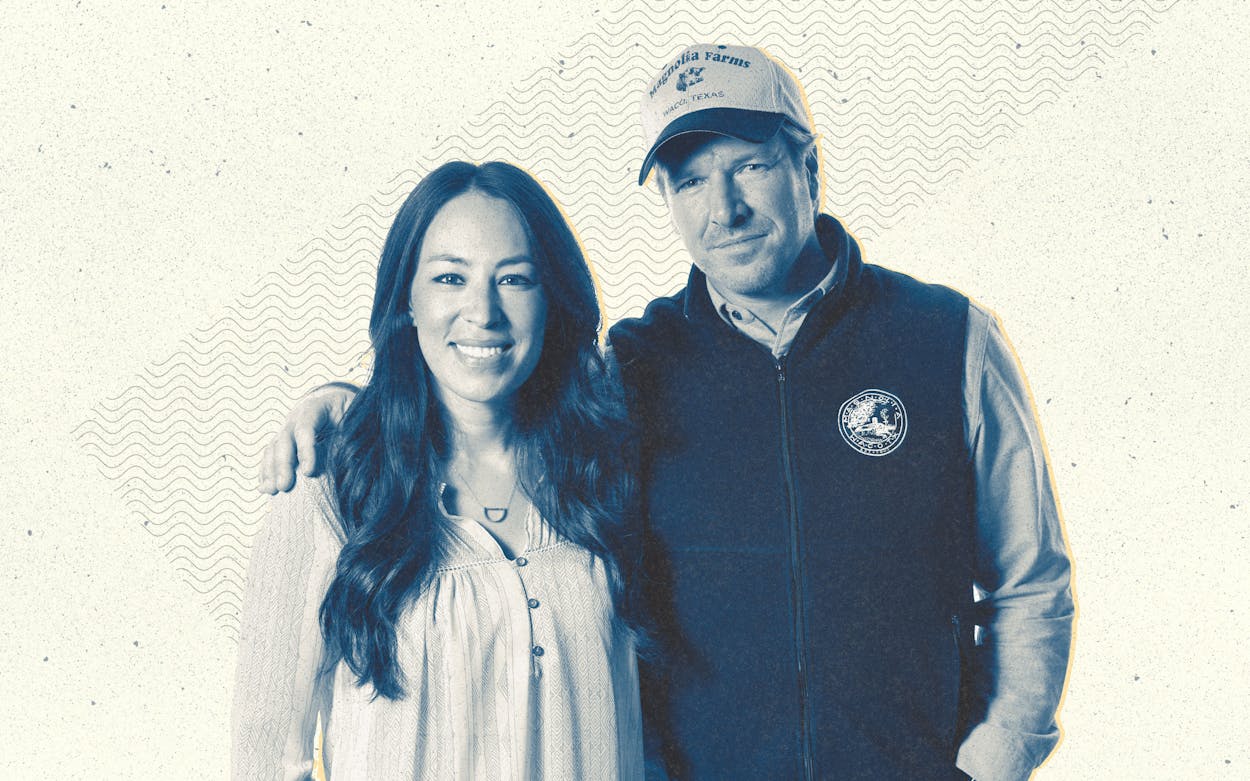Even if you’ve never seen an episode of Fixer Upper, you probably know what shiplap is because of it. More specifically, you understand the aesthetic import of that weathered wood because of the show’s stars, Waco transplants Chip and Joanna Gaines. Without tuning in to any of the HGTV show’s five seasons, you still might have found yourself standing in line at the Gaineses’ Magnolia Market at the Silos, or feeling like you know Chip—the big, lovable goofball—and Joanna—the diligent visionary. Some phenomena transcend the medium in which they started and become something else entirely. So when the final episode of Fixer Upper airs Tuesday night, bringing an end to the five-year reality TV run, it’ll be sad for the Gaineses’ fans, but the impact the couple has had—on Waco, on design, on the real estate dreams of a whole lot of people around the country—is much bigger than a TV show.
For many years, Waco served as shorthand for “the Branch Davidian massacre” to the outside world. (The Paramount Network miniseries about the event was simply called Waco, and nobody outside of the city ever seemed to care that the complex was actually just outside the town of Elk.) The city has had unfortunate brushes with bad PR—the Twin Peaks biker shootout, the Baylor sexual assault scandal—but whatever easy narratives might exist about the place were disrupted by the existence of the Gaineses and Magnolia Market.
Former longtime McLennan County sheriff Larry Lynch, who knows a thing or two about the city’s reputation in the wake of the Branch Davidian siege, attributes a shift in the way the city of Waco is viewed—by locals and outsiders both—to the stars of Fixer Upper. “We went from [the Branch Davidians] to Chip and Joanna,” Lynch told Texas Monthly‘s Eric Benson in January. “Our city’s growing, and I really think that Chip and Joanna Gaines have made a big positive impact here in McLennan County.”
In 2015, before the opening of the Magnolia Market at the Silos in downtown Waco, the city attracted 660,000 visitors. The following year, after the store/outdoor complex/bakery was open for a full year, more than three times as many people flooded in (and, if the line for the Silos Baking Co. is any indication, at least half of them got chocolate chip cookies). According to Zillow, in 2016 and 2017, home values spiked by nearly 20 percent over those years. (Housing experts have expressed concern that the spike might be more than the city is built to handle—though a price dip in early 2018 has thus far been slight.) Anecdotally speaking, if you talk to someone at the Dallas tourism office, you’ll learn that one of the hot activities for people flying into DFW or Love Field is to rent a car and drive down to Waco. There, you can take one of the handful of Fixer Upper–themed tours offered by various companies—all of which culminate with a stop at the Silos.
Even on a weekday afternoon, you’ll still either have to pay for parking or hike on over, and the lines will be long, the shop crowded. It’s not as if what Magnolia Market sells is revolutionary or rare, either. There are metal planters, wooden utensils, woven baskets, rough-hewn pillows, wall signs in metal or wood with pleasant, vaguely inspirational slogans emblazoned on them. And the shiplap—my god, the shiplap. The aesthetic is the sort of thing you might have found in a homey hipster coffee shop in Austin or Brooklyn or Chicago in the mid-aughts, refined into cohesive design elements that are increasingly familiar to people who look at contemporary trends in decorating. It’s stuff that you see a lot of places, these days, and it’s fair to say that you see so much of it because Fixer Upper launched the Joanna Gaines aesthetic into the mainstream. A decade ago, the stuff you buy at Magnolia Market might have been uncommon finds, but these days, you can get it there, or you can get it at Target.
But still, the visitors come to the Silos. The Silos are a fascinating, tangible expression of the connection the Gaineses have managed to build with their fans. Fans come to the Silos because they want to be closer to them—you can buy shiplap on Amazon, but you don’t get to shop for it in a space that Chip and Joanna Gaines designed if you do it that way. The Wizarding World of Harry Potter gives visitors to Orlando a chance to interact with a fandom that means a lot to them—what the Gaineses understood intuitively is that people form close connections to the reality show stars they watch, too, and if they built a theme park of their own right in the heart of Waco, replacing the rides with lawn games, food trucks, and a couple of shops, they could get people to make similar pilgrimages. The genius of the Gaineses is that they built all of this on their own terms, in the town where they went to college and fell in love, and created something so culturally dominant.
When the final episode of Fixer Upper ends on Tuesday, the Silos, and the aesthetics they helped popularize, will be driven less by the force of the Gaineses’ personalities. But the immediate future, at least, looks bright: The impact the Gaineses have had—on Waco, on design, on future reality TV stars—may not last through centuries to come, but you don’t even have to have ever seen a single episode of Fixer Upper to feel it right now.
This piece has been modified since publication.








